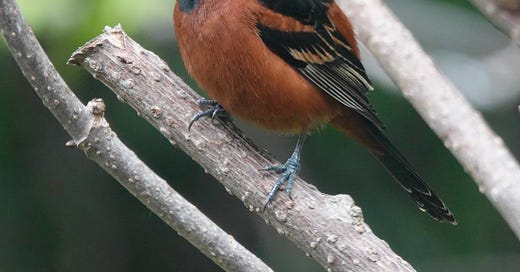Naturally
I listened to a brown thrasher and its gleeful, repeated musical phrases. I want to sing along, but I don’t know the words. I recited the human words from the mnemonic I’d learned in my youth. "Plant a seed, plant a seed; bury it, bury it; cover it up, cover it up; let it grow, let it grow; pull it up, pull it up; eat it, eat it."
I love watching the exploits of birds. Starlings insert their bills into the ground, then pry their mandibles open, creating a space to grab prey. I don’t mind seeing those birds. I’ve developed starling callouses.
Q&A
Mark Monlux from Tacoma asked what the skinny was on feeding hummingbirds. The best solution for your hummingbird feeder is a 1:4 solution of refined white (table) sugar to tap water. That’s ¼ cup of sugar in 1 cup of water. Bring the solution to a boil, then let it cool before filling the feeder. You can make a larger batch and refrigerate the extra solution. Remember to bring it to room temperature before refilling the feeder. During cold, rainy or foggy conditions, when fresh water is plentiful but birds need more energy, it’s OK to make the mixture ⅓ cup of sugar per cup of water. Concentrations of sugars in nature vary within that range. If you mix up small quantities of sugar water every day or two, there’s no need to boil the water. There’s no need to add red food coloring to sugar water or use red-colored commercial mixes. Nectar in flowers is clear. It’s the flowers themselves that are brightly colored, not the nectar. Don’t use brown sugar, honey, molasses, fruit juice, artificial sweeteners or syrup instead of white sugar. If you see any cloudiness or mold in the water, then it needs to be replaced. A rule of thumb is that if you wouldn’t drink it, don’t feed it to hummingbirds.
“What scientist proved that bumblebees shouldn’t be able to fly?” None. The popular myth began in 1934, when the French entomologist August Magnan noted that a bee's flight should be impossible. Bees flap their wings back and forth, not up and down. Bees should be able to fly according to the laws of physics because they do fly. Their wings twist and rotate, creating enough lift to make it possible for bees to become and remain airborne.
“When do chickadees and mourning doves nest?” Black-capped chickadees nest from mid-April through late July and have a single brood. In Minnesota, dove nesting extends from early April until early October, with a peak in early June. Minnesota doves average about three nesting attempts per year.
Linda Ebeling of Trimont asked why goldfinches aren’t eating the Nyjer seeds and how to stop a cardinal from fighting with a house window. Goldfinches are picky eaters and want fresh seeds. Nyjer has a high oil content and thin shells, and provides protein and energy. When Nyjer (thistle seed) gets wet, it clumps like cat litter and can spoil or become moldy. Shake the seed in the feeder. The seed should move around freely. If it clumps, water has gotten into the feeder. If this happens, the finches lose interest. If Nyjer gets moldy, remove it from the feeder and clean the feeder with a 10% bleach-water solution. Oily seeds can go rancid, emitting a foul odor. Sniff them, and you’ll know if the seed has turned rancid. Nyjer seed can also dry out. Crush the seeds onto a white paper towel and look for oil blotches. If oil stains are present, the seed is fresh. If the seeds look dull and aren’t shiny, replace them with a fresh batch. Nyjer seed isn’t derived from thistles, but from an African yellow daisy. Sources claim Nyjer seeds last up to six months, but it’s a good practice to replace the seeds every three to four weeks.
After choosing a nest site, a pair claims a territory and defends it from other cardinals. When one male spots another, a chasing fight ensues. The dominant male gets a mate, the desired territory and the area’s food. The window acts as a mirror. A cardinal is territorial and makes an enemy of its image. The reflection refuses to flee. Being persistent and stubborn, the cardinal refuses to enter into peace talks with itself. Soap the outside of the window or cover the glass with cardboard, black nylon screen, painter’s cloth, or plastic cling to block the assailant’s image. Covering the inside of the window enhances reflections. Plastic owls and fake snakes don’t help.
Thanks for stopping by
“Find tongues in trees, books in the running brooks, sermons in stones, and good in everything.”―William Shakespeare, “As You Like It.”
“To learn something new, take the path that you took yesterday.”—John Burroughs.
Do good.
©Al Batt 2025
This male orchard oriole is smaller than a Baltimore oriole. He has a rich chestnut color, and the Baltimore oriole male has a flame orange color. The orchard oriole eats insects, nectar and fruit. Like the Baltimore oriole, it has a sweet beak and will visit orange and jelly feeders. Photo by Al Batt





"Bees should be able to fly according to the laws of physics because they do fly." Just wow.